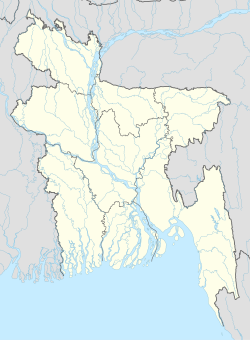Top Qs
Timeline
Chat
Perspective
Gulshan Thana
Thana and upscale area in Dhaka, Bangladesh From Wikipedia, the free encyclopedia
Remove ads
Gulshan (Bengali: গুলশান, romanized: Gulaśāna) is an affluent residential and business neighbourhood,[7][8] as well as a thana (police jurisdiction) situated in Dhaka, Bangladesh.[9]
Originally a rural settlement called Bhola Gram, the area was developed in the early 1960s into an upscale suburban neighbourhood with planned housing and infrastructure. Gulshan underwent a major transformation beginning in the 1990s, evolving into a dense urban zone with high-rise buildings, shopping centres, banks, hotels, private clubs, and diplomatic missions. Today, it is home to a number of the city's restaurants, five star hotels,[10] shopping centres, schools, banks, offices, and clubs. It also hosts the majority of foreign embassies and high commissions in Bangladesh. Many Bangladeshi and international companies have their offices located in Gulshan.[11][12]
Remove ads
History
Summarize
Perspective
Until 1961, the area now known as Gulshan (meaning "garden") was a rural settlement outside of Dhaka called Bhola Gram or Bhola Samair (Bengali: ভোলা সামাইর), inhabited by migrants from Bhola District in Barisal. It featured croplands, dense vegetation, and water bodies used for fishing. The Dhaka Improvement Trust (DIT), under G.A. Madani, selected the site for the Gulshan Model Town project, aiming to develop a planned residential area inspired by a similar neighbourhood in Karachi. As affluent residents began acquiring land and constructing homes, the area's rural character gradually transformed. During this period, Gulshan was designated a union and later upgraded to a municipality. The previous inhabitants were relocated to nearby locations such as Badda, Notun Bazar, and Gazipur. Around 1972, Gulshan and surrounding areas were organised under the newly formed Gulshan Thana. In 1982, the municipality was absorbed into Dhaka Municipality as a ward.[9][13][14]
Initially developed as a residential area with one- and two-storey houses, Gulshan began to see the construction of high-rise buildings in the 1990s. Like other parts of Dhaka, it evolved into a densely developed urban zone, featuring street lighting, security checkposts, high-rise residences, kitchen markets, shopping malls, brand outlets, banks, clubs, gyms, and hotels. Diplomatic missions and residences also expanded eastward into Baridhara, while surrounding areas grew in significance.
Rapid development continued into the following decade, leading the government in 2004 to officially permit commercial establishments in designated parts of Gulshan. This policy shift triggered a sharp rise in the number of commercial buildings, shops, and a significant increase in land and property prices.[9][13]
Banani was a part of Gulshan Thana, but was separated with the establishment of Banani Thana. Despite this, Banani and Gulshan are often referred together as "Gulshan–Banani", due to their proximity, same characteristics and history and being in the same thana, before the establishment of Banani Thana.[citation needed]
Remove ads
Geography
Summarize
Perspective
The Gulshan Thana comprises an area of 8.85 km2, consisting of ward 18 and ward 19 (partial),[15] including Gulshan Model Town, consisting of Gulshan circle 1 and circle 2, Baridhara Diplomatic Zone, Mohakhali,[16] and Niketan Housing Society.[17] 50% of the area is residential, 20% commercial and 12% is the diplomatic area. 18% of land in Gulshan consists of other areas, including slums, of which the biggest is the Karail slum. The Gulshan Lake,[18] is also located in the area.
Gulshan is a commercial and residential area,[19] originally meant for offices and embassies of diplomatic missions, as well as residences. The area has seen an upsurge in the number of high-rise buildings, restaurants, residential areas, modern markets and ice-cream parlors since the mid-1990s.[20] The independent houses of the early 1970s that stood far from each other in the Gulshan area have vanished because of the commercial boom, to the point that older residents claim it is no longer a residential area.[21]
Though Gulshan, Banani and Baridhara, as well as Uttara and other satellite towns like Bashundhara, are relatively on higher lands, substantial parts of the Gulshan Thana area remained underwater for a prolonged duration during the 1998 Bangladesh floods. Dhaka WASA conducted a survey to investigate the causes of and remedial measures in 1998 with a particular focus on the Gulshan Lake and the Gulshan and Banani canals. Flood water runoff flows into these water bodies practically turning these into buffer flood control reservoirs, except for some pockets of transient water-logging.[22][23] Drains and sewerage pipes dumping wastes in the Gulshan lake has been identified as major pollution problem by DWASA.[24] The malodorous wastes tend to spill over when the roads are flooded.[25]
Remove ads
Demographics

According to the 2011 Census of Bangladesh, Gulshan Thana had 54,215 households with an average household size of 4.14 and a population of 253,050. Males constituted 55.45% (140,322) of the population while females 44.55% (112,728). Gulshan Thana had a literacy rate (age 7 and over) of 74.8%, compared to the national average of 51.8%, and a sex ratio of 124.There were 1,743 floating people in this jurisdiction.[27]
The religious breakdown was Muslim 91.37% (231,208), Hindu 3.97% (10,045), Christian 3.88% (9,809), Buddhist 0.67% (1686), and others 0.12% (302). The ethnic minority people living there were 3,891 individuals in total.
Urban layout


Thoroughfares in the area are beautified by major cellphone companies of Bangladesh.[28] There are 25 mosques in this area, including Gulshan Azad Mosque and Gulshan Society Mosque. The area features a number of churches and Christian missions, including that of the Missionaries of Charity. There are some public urban parks in this area including Justice Shahabuddin Ahmed Park[29] and Shahid Dr. Fazle Rabbi Park.[30]




Commercial activities
Remove ads
External links
 Media related to Gulshan at Wikimedia Commons
Media related to Gulshan at Wikimedia Commons- Ward 19 Archived 29 July 2020 at the Wayback Machine, Prothom Alo (Bengali)
Wikiwand - on
Seamless Wikipedia browsing. On steroids.
Remove ads





